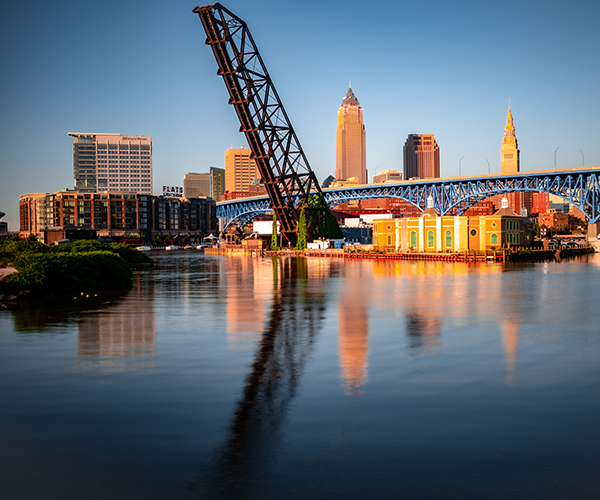Defying the Odds
by Amy Bracken Sparks | Jun. 20, 2007 | 4:00 AM
After three years of radical cosmetic and reconstructive surgery, the Akron Art Museum hosts its big reveal this month on that very date with the celebration of its Defy Gravity benefit. The grand opening continues with members-only previews July 13 and 14, a free sneak peek for the public July 15 and a ribbon-cutting ceremony July 17. With new, cantilevered glass “wings” hovering high in the air, the experimental building design that seemingly defies gravity puts Akron on the international map, and in the process, Northeast Ohio receives a jolt.
The first of several major museum expansions in the area, Akron’s $34 million project — named for well-known native Akron philanthropists John S. and James L. Knight — serves as a litmus test of sorts. The question is not whether the public will embrace such gleaming new structures. They already have. The real question is how the new structure will serve the art it’s meant to display.
Museums have long since shed their mausoleum status, serving instead as the public pulse of a city and glamorous pieces of real estate. Intended to be magnets for tourists and economic development, they are the new public squares — “civic focal points,” according to Mitchell Kahan, Akron Art Museum director.
The fact that there might be great art just around the corner is a bonus.
The History
Formerly housed in an 1899 Renaissance-revival building that once served as a post office, the Akron Art Museum has consistently enjoyed a stellar reputation since its founding in 1922. Its forward-looking focus on contemporary art made it a haven for art-lovers who wanted to view the art of their own time. Clevelanders, especially, often made the short trek to the Akron Art Museum before the Cleveland Museum of Art boosted its contemporary collection in the 1990s.
But as Akron’s permanent collection grew, and art forms embraced new media and became technologically challenging, the charming, 19th-century red brick building on East Market Street started pinching the staff, the collection and the programming. Less than 1 percent of its permanent collection could be displayed, and the museum had to pass on many traveling exhibitions that were too large for its space. In 1999, the museum began considering an expansion.
Unfortunately, architecture wasn’t faring well at the time, especially in the United States. “Buildings used to be potent symbols, civic monuments that were built to last,” Kahan said in 2003. “Now, very few clients are willing to invest in architecture. They just want structures.” And, as we have seen in Greater Cleveland and elsewhere recently, nearly any structure can be deemed expendable.
Enter Viennese architecture firm Coop Himmelb(l)au, which won the museum’s design competition in 2001. In the fiercely competitive, highly theoretical and ego-driven world of architecture, Coop Himmelb(l)au’s principals are rock stars (self-described and otherwise).
The first clue is its name. Coop can be read as co-op, as in cooperation and collaboration. Himmel is a word for “sky” or “heaven” in German; bau means “building,” and blau means “blue.” The two meanings of Himmelb(l)au are “blue sky” and “sky building,” implying that its style of architecture literally reaches for the sky. All great architecture seeks to erase the line between earth and sky, but few architects dare to put it in their name.
Indeed, many of its current projects have footprints much smaller than their “wingspans.” At once boxy, sleek and airborne, Coop Himmelb(l)au’s designs in France, Germany, Switzerland, Mexico, China and the Netherlands more resemble sculpture in flight than buildings. They are perpetually poised for takeoff.
Akron’s new building does seem to defy gravity, but it’s also metaphorical: economic downturns, arts funding lows and Rust Belt woes won’t keep this museum from soaring.
The Akron Art Museum is not only Coop Himmelb(l)au’s first completed U.S. building, but also it offered principal architect Wolf D. Prix an additional challenge: Keep the original 19th-century building and incorporate it into the design, which was no small feat.
The Design
The new museum’s design has three distinct architectural elements. “The Crystal” is the building’s public face: a three-story glass lobby that serves as the new front entrance and connects to the museum’s public programming, exhibition, education and administrative spaces. However, the word “lobby” seems inadequate to describe this space. It’s more like a city plaza enveloped in glass.
The building’s new and flexible “Gallery Box” exhibition space looks like a gleaming rectangle from the outside and provides more than 20,000 additional square feet for temporary exhibitions and the permanent collection. (The old building alone was around 21,000 square feet.)
Above it all is a signature element Prix calls the “Roof Cloud”: a 300-foot-long steel armature cantilevered above both the old and new building. If one building can cradle or cuddle another, this is it.
“The design embraces the past rather than replacing and destroying it,” says Prix. “It uses architecture to create a public space within the city and a private space within our own souls — reinventing both the city and ourselves at the same time.”
The new building seems to emerge from the old like an exotic, glassine insect escaping its hard cocoon. One whole wall of the old building was removed to help stitch up the seam between the two. The museum also commissioned an enormous, site-specific mural by American artist Sol LeWitt to be installed where the old and new buildings join.
“We are involved in the preservation of history as well as in innovation and the future,” said Kahan. Combining new and old “is a perfect symbol for our institution.”
The warmth and hand-wrought look of the old brick building provides a sharp contrast to the new. The two may now be structurally integrated, but the old building is a poignant reminder of another time and place, a kind of memory marker that connects the viewer to the past.
Architects, civic leaders, arts patrons and philanthropists — risk-takers all — look to the new Akron Art Museum as a well-timed, well-conceived gamble. It’s a fraction of the cost of the Cleveland Museum of Art’s ongoing expansion, and far more avant-garde than the Frank Gehry building in University Circle at Case.
A museum is nothing, however, without people. All bets are on the public arriving early and often.
Also look for a newly commissioned piece, Women at an Exhibition, a multimedia work by composer Randall Woolf and filmmakers Mary Harron and John C. Walsh that mines and reuses images from the museum’s permanent collection.
Prized Images: The Knight Purchase Award for Photographic Media 1991-2006 is a selection of 118 photographic works from the permanent collection and is a more traditional exhibition that makes use of some of the building’s new space.
Rounding out the opening exhibitions is one concerning the building itself. From conception to completion, including sketches, digital renderings, photographs, and plans of the design and the construction, Building the New Akron Art Museum details the museum’s renovations.
Trending
-
1
-
2
-
3
-
4
-
5










